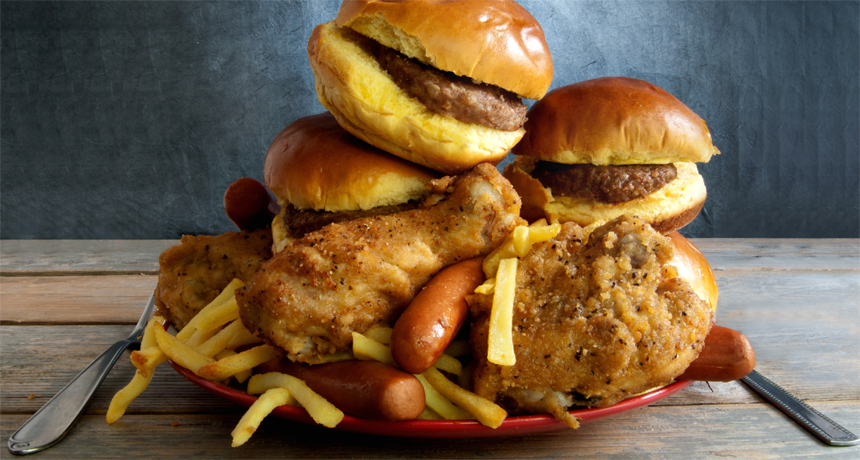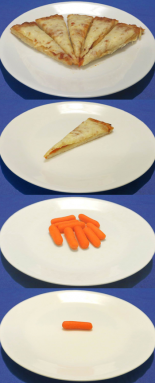Just viewing super-size meals can promote overeating
Brain imaging shows that kids’ brains process the size of food servings and the calories in them quite differently

People who get large servings of food eat more than those who get small servings. What are their brains telling them?
CharlieAJA/istockphoto
A girl sits down to a plate loaded with pizza. A boy gets a few baby carrots. Immediately, both kids’ brains start taking stock what’s in front of them. Consciously, the kids might be thinking “Yum” or “Yuck.” But their brains are also processing how much food is there — a feast, or just a nibble. And they’re cataloguing whether it contains a lot of calories per bite or just a little. Different parts of the brain are responsible for handling these two questions, a new study finds. The answers they come up with could limit the diner’s self-control.
Studies show that the more food there is on a plate, the more someone is likely to eat. Nutritionists call that the “portion size effect.” It doesn’t matter what kind of food it is. It also doesn’t matter whether the diner is young or old, male or female, alone or in a group. The bigger the portion, the bigger the appetite.
Laural English is a nutritionist at Pennsylvania State University in University Park. She knows that many eating habits that kids pick up in early childhood will still be there when they are adults. So she and her colleagues wanted to find out what happens in the brain when a child sees a large portion of food. Knowing what drives kids’ eating habits might help families create healthier lifelong habits.
Calories are a measurement of the amount of energy contained in food. English and her team also wondered if it matters whether a large serving is packed with calories (such as pizza), or less energy dense (such as carrots).
“When you’re sitting down to eat a meal, you don’t appreciate all the different impacts or cues in front of you,” notes Kathleen Keller, who helped run the study. “Size, smell, taste, the way food is presented — all have an impact on what the brain perceives and also what you eat,” she says. The new study is the first to look separately at how the brain reacts to portion size and the calories in it, she says.
What happens when the brain perceives a meal?
The research team recruited 36 children to take part. All were aged 7 to 10. Half were boys, half were girls. Nearly all had a healthy weight. To make sure that all of them were hungry, the researchers asked the kids not to eat for two hours before the study began. When kids arrived, the researchers had them climb into a magnetic resonance imaging (MRI) machine. It looks like a giant donut standing on its side, with a bed sticking out of the center. It uses magnets and radio waves to map the flow of blood in someone’s body.

Each child had to lay down on the bed with his or her head inside the donut. Staying very still was important. Moving one’s head more than the thickness of a dime would ruin the scan, notes Keller. To help avoid that, she says, “We had them dance and move and get all their wiggles out before the scan.” In the end, those kids aced the MRI. In fact, Keller says, “I think they accepted it better than adults do.”
Brain areas that are most active will light up on the scans. These areas show where their blood flow is highest. The researchers wanted to see if the areas that lit up differed when kids viewed pictures of large amounts of food or just small portions. They also wanted to know if different brain areas lit up when the foods had been high or low in calories.
Inside the machine, the children viewed a series of 150 photos. Some pictures showed an energy-dense food, such as pizza or cookies. Others showed a low-calorie food, such as carrots or green beans. Each food was shown twice, once as a very small amount and once in a very large portion. The food pictures were mixed with images of furniture and other non-food objects. The extra pictures helped the researchers make sure that any effects they found were truly related to seeing food.
When they analyzed the scans, the researchers found that a child’s brain processed information about a food’s calories differently than it did about food quantity.
Seeing large amounts of food reduced activity in one brain area, compared with seeing smaller portions. That area is called the inferior frontal gyrus (JY-rus). Previous studies have linked this area to self-control. It’s involved with “decision-making and getting you to stop behaviors once you start,” Keller explains. If just seeing large portions of food suppresses activity in this area, that might help explain why it’s so hard to stop eating from a giant bowl of popcorn or a big carton of blueberries.
The Penn State team also found that several different brain areas responded to a food’s calorie content. Seeing images of high-calorie foods activated brain areas that process taste and the feeling of pleasure. That pleasure is why these foods typically seem more delicious — and tempting — than low-calorie foods. This result matched reports from previous studies in adults.
The team described its findings in the February American Journal of Clinical Nutrition.
Martin Binks is a clinical psychologist at Texas Tech University in Lubbock. He studies the brain and behavior as they relate to obesity. He was not involved in the new research, but says it’s an important study. It points to how complex the eating experience is, he says. However, one study is not enough to link portion size to specific areas of the brain, he adds. It’s possible that other things, such as a food’s color, could have affected brain responses. “There’s work to be done before drawing any firm conclusions,” he says.
Portion sizes affect some more than others
Kids who took part in English’s study also visited the lab several times before their brain scan. On each visit, they ate a meal. The meals included different amounts of high- and low-calorie foods. The researchers tracked how much each child ate. At first, they did not see any link between eating and a brain’s response to pictures of food.
But then the researchers looked at their data in a new way. They zoomed in on just the inferior frontal gyrus. That’s the brain area that tended to become less active when kids saw big servings of food.
This time, some of the kids “seemed to be protected from the portion size effect,” says Keller. These kids resisted eating too much when given large portions at meal time. Their brains also responded differently in the scanner. In these kids, seeing pictures of large portions of food did not cause activity in the brain area involved in self-control to drop as much as it did for most kids. These findings have not yet been published in a peer-reviewed journal. First, other scientists will have to review the findings and confirm that the data seem strong.
Currently, doctors and nutritionists use one-size-fits-all approaches to curbing unhealthy eating habits. Knowing why some kids overeat should make it easier to help them develop healthier habits to last their entire lives, says Keller. But if different kids have different reasons for overeating, that will have to be taken into account. Peering into their brains might help researchers develop therapies to fit each person’s own needs.
Studying the brain’s responses to food might also lead to new drugs to help combat obesity, says Binks.
Keller hopes that the food industry will also pay attention to her team’s findings. There are lessons here, she says, for creating packaging that makes people more likely to choose healthy foods and reasonable portion sizes.







